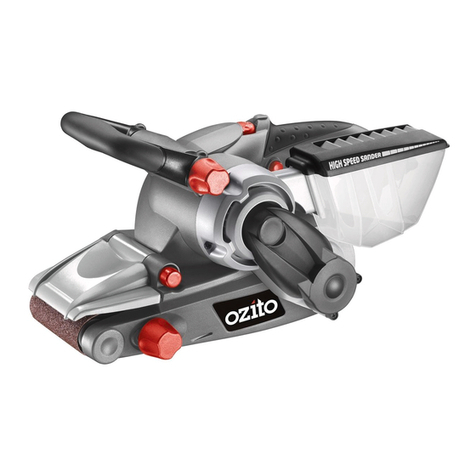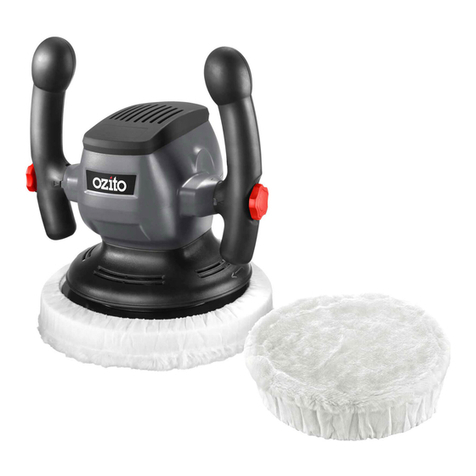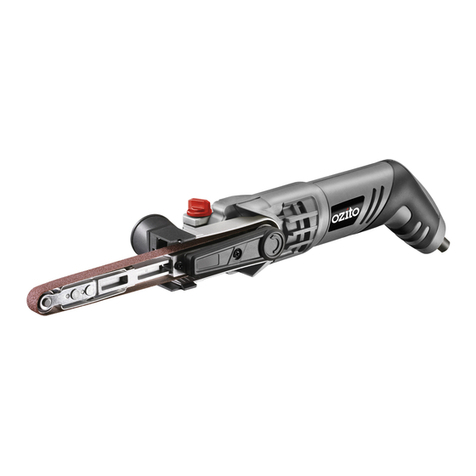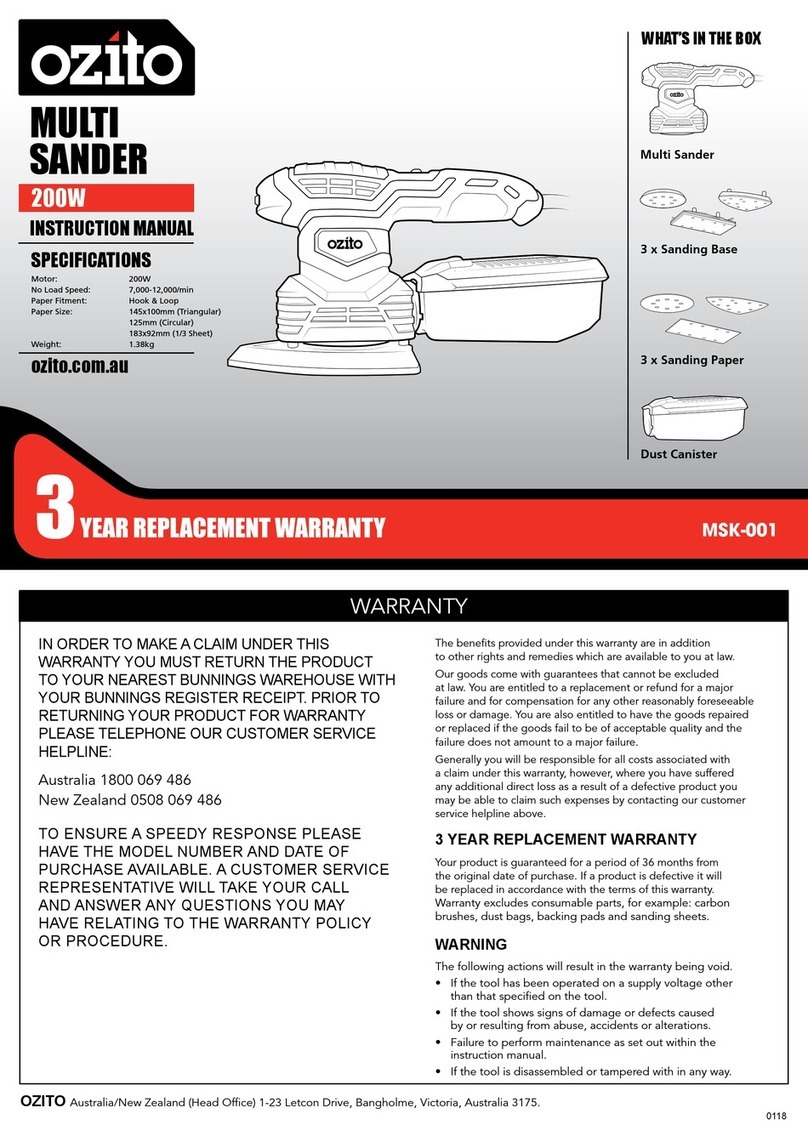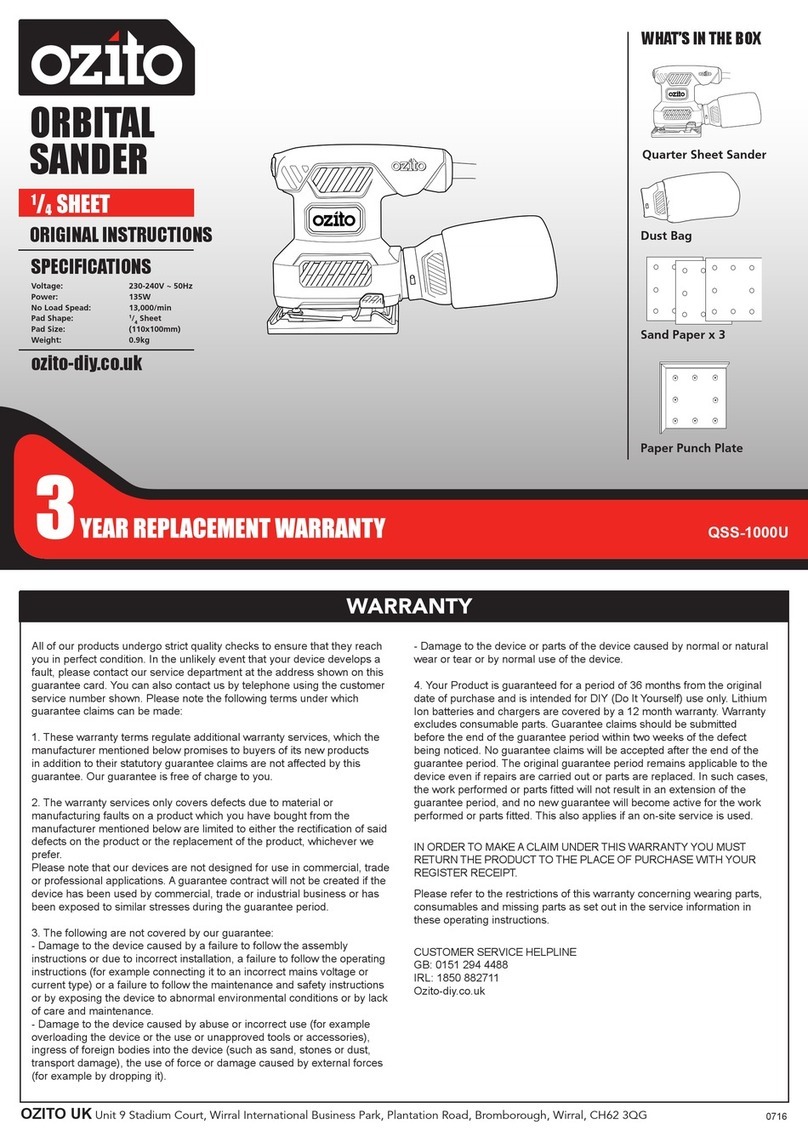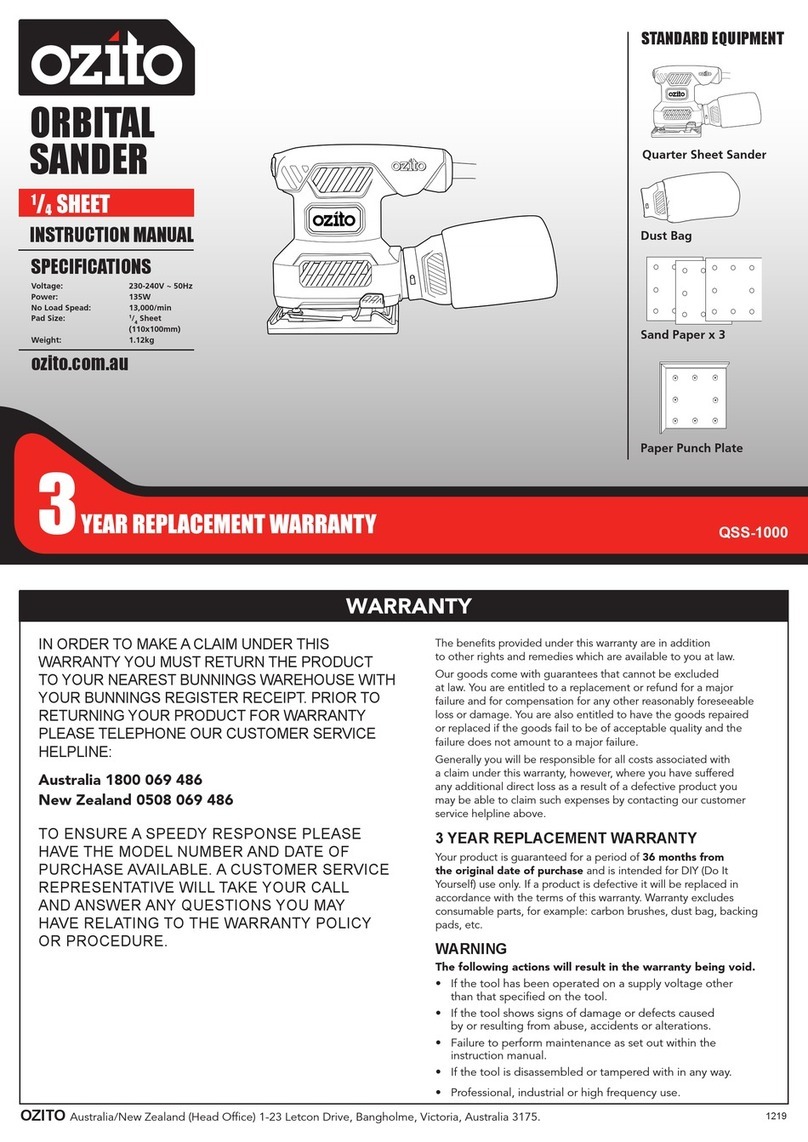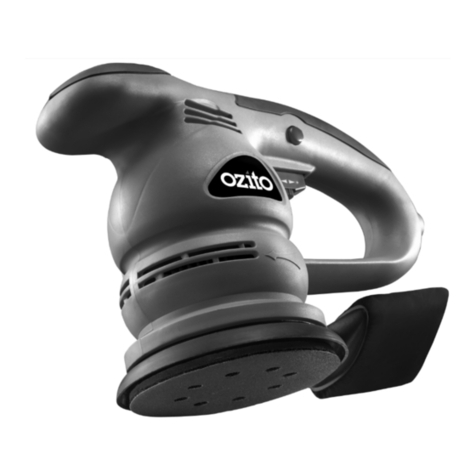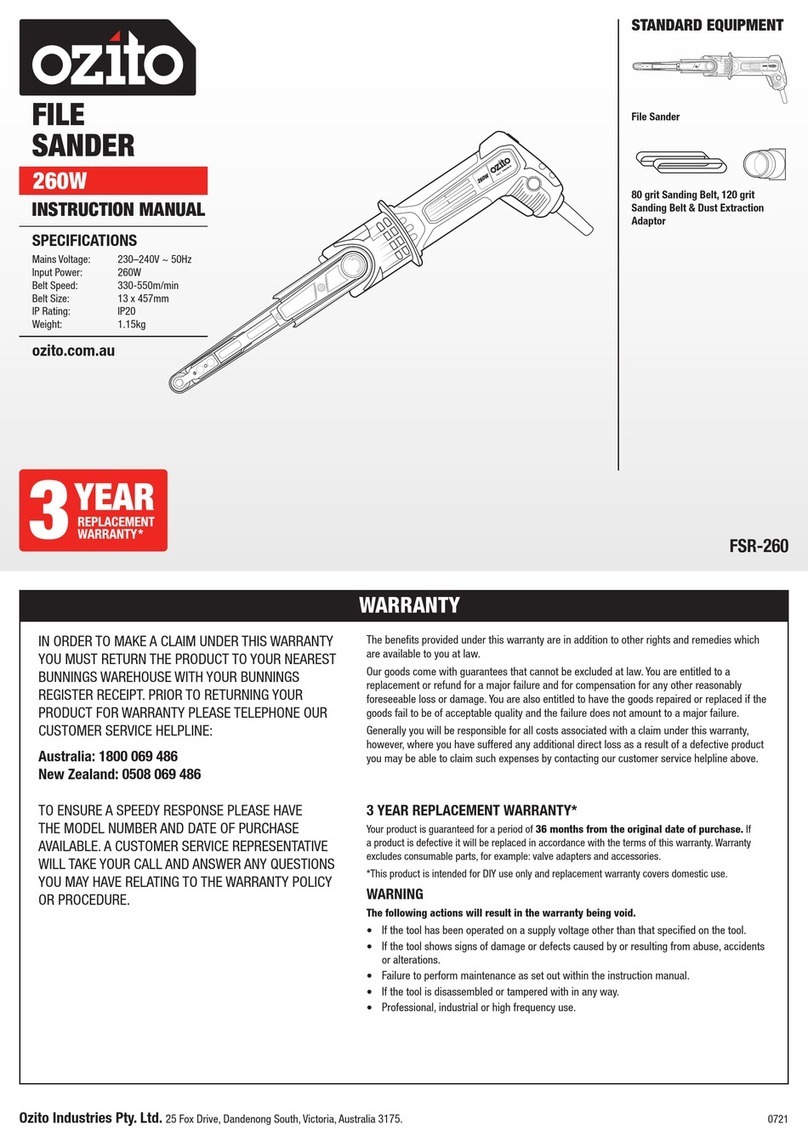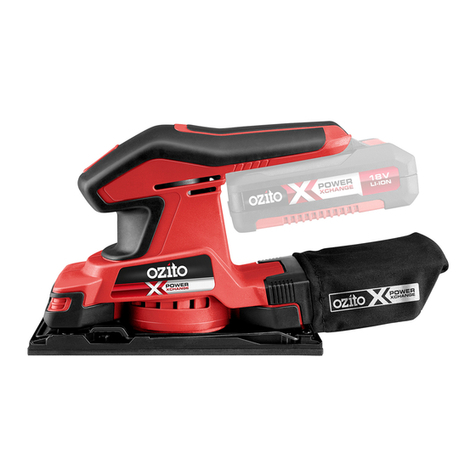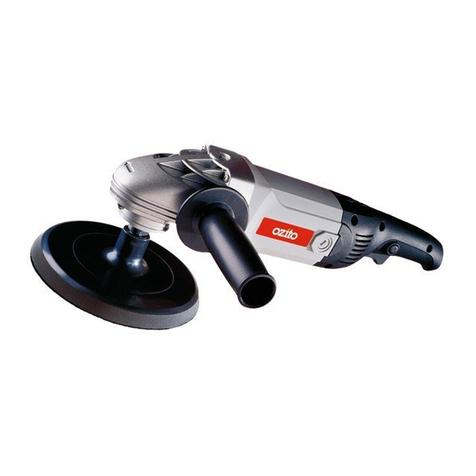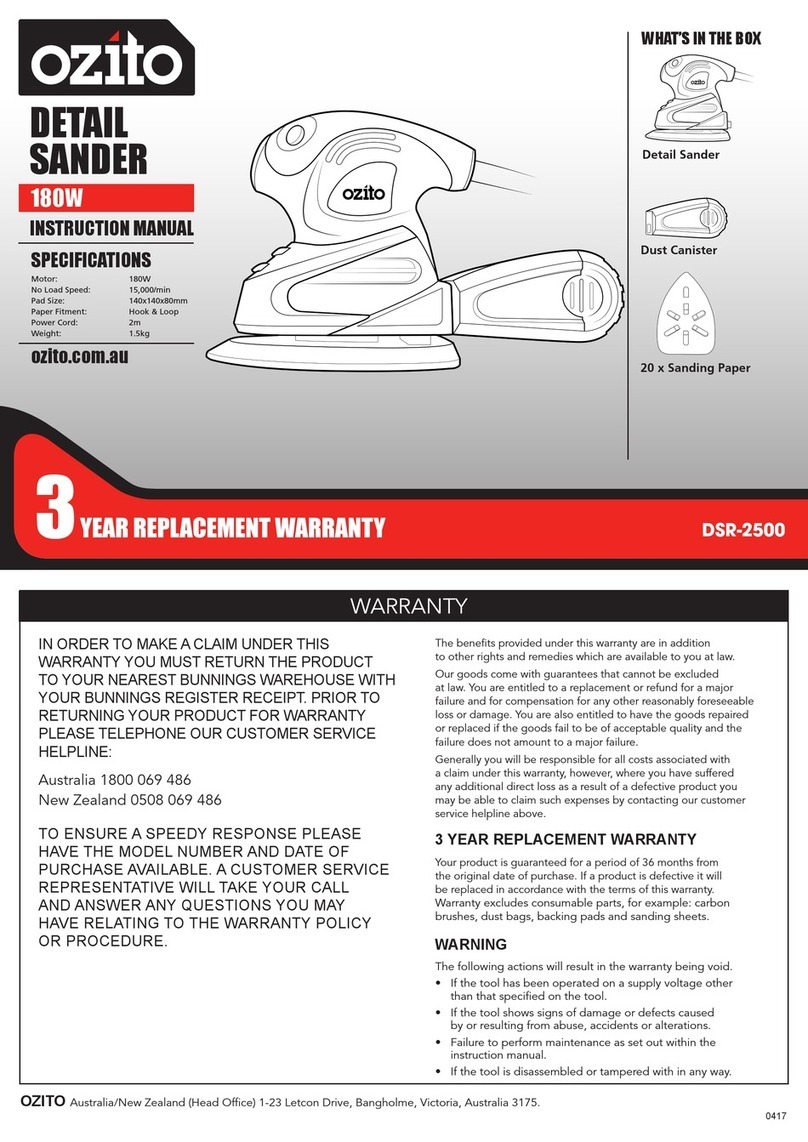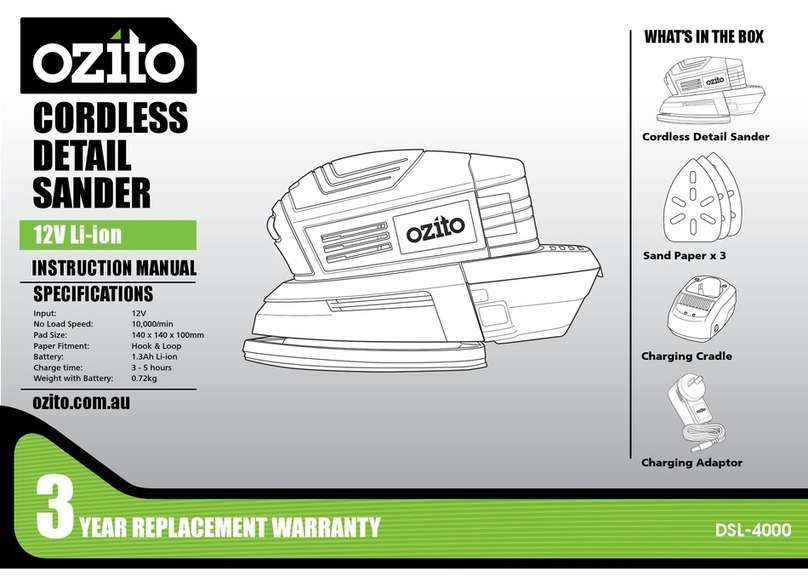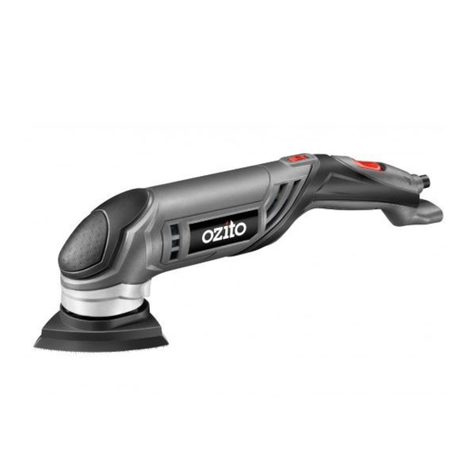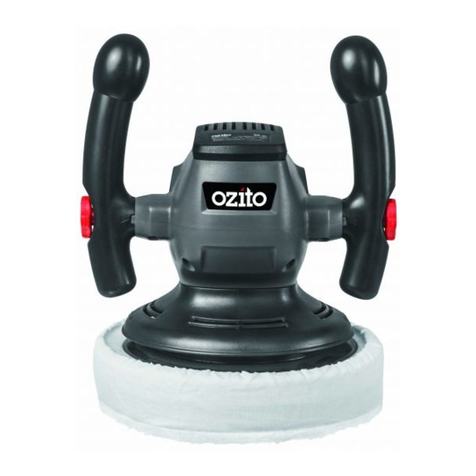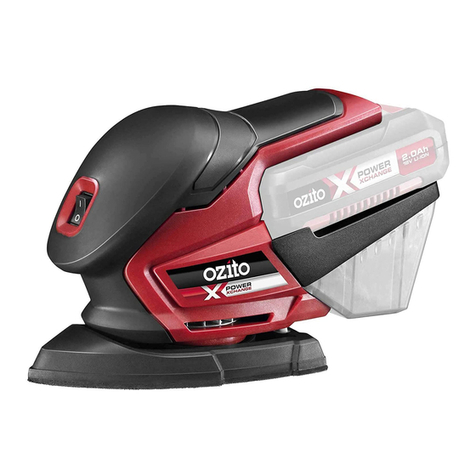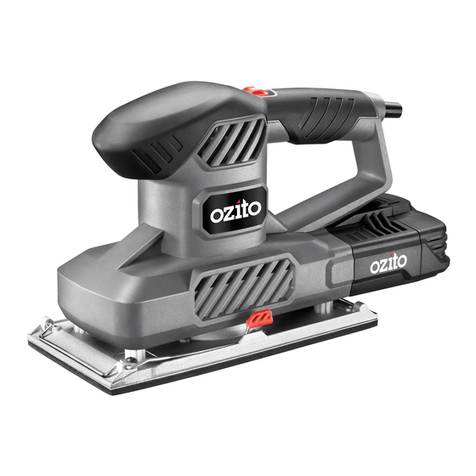
WARNING!
• Hold power tool by insulated gripping surfaces, because the sanding pad
may contact its own cord.Cuttinga“live”wiremaymakeexposedmetalpartsof
thepowertool“live”andcouldgivetheoperatoranelectricshock.
Recommendation that the tool always be supplied via a residual current device
with a rated residual current of 30 mA or less.
Unplug the sander before changing accessories.Accidentalstart-upsmayoccurif
thesanderispluggedinwhilechanginganaccessory.
Disposing of dust.Beextremelycarefulofdustdisposal,materialsinneparticle
formmaybeexplosive.Donotthrowsandingdustonanopenre.Spontaneous
combustion,mayintime,resultfromamixtureofoilorwaterwithdustparticles.
Always wear eye protection and a dust mask for dusty applications and when
sanding overhead.Sandingparticlescanbeabsorbedbyyoureyesandinhaled
easilyandmaycausehealthcomplications.
Use special precautions when sanding chemically pressure treated timber,
paint that may be lead based, or any other materials that may contain
carcinogens.Asuitablebreathingrespiratorandprotectiveclothingmustbeworn
byallpersonsenteringtheworkarea.Workshouldbesealedbyplasticsheetingand
personsnotprotectedshouldbekeptoutuntilworkareaisthoroughlycleaned.
Do not ‘wet sand’ with this sander.Liquidsenteringthemotorhousingarean
electricalshockhazard.
Do not use sandpaper intended for larger sanding pads. Largersandpaperwill
extendbeyondthesandingpadcausingsnagging,tearingofthepaperorkick-back.
Extrapaperextendingbeyondthesandingpadcanalsocauseseriouslacerations.
WARNING!
Somedustcreatedbypowersanding,sawing,grinding,drillingandother
constructionactivitiescontainchemicalsknowntocausecancer,birthdefectsorother
reproductiveharm.
Someexamplesofthesechemicalsare:
• Leadfromlead-basedpaints;
• Crystallinesilicafrombricks,cementandothermasonryproducts,and;
• Arsenicandchromiumfromchemically-treatedtimber.
Yourriskfromtheseexposuresvaries,dependingonhowoftenyoudothistypeof
work.Toreduceyourexposuretothesechemicals:workinawellventilatedareaand
workwithapprovedsafetyequipment,suchasdustmasksthatarespeciallydesigned
tolteroutmicroscopicparticles.
DETAIL SANDER SAFETY WARNINGS
WARNING! When using mains-powered tools, basic safety precautions, including the
following, should always be followed to reduce risk of re, electric shock, personal injury
and material damage.
Readthewholemanualcarefullyandmakesureyouknowhowtoswitchthetooloinanemergency,before
operatingthetool.
Savetheseinstructionsandotherdocumentssuppliedwiththistoolforfuturereference.
Theelectricmotorhasbeendesignedfor230Vand240Vonly.Alwayscheckthatthepowersupply
correspondstothevoltageontheratingplate.
Note:Thesupplyof230Vand240VonOzitotoolsareinterchangeableforAustraliaandNewZealand.
This tool is double insulated therefore no earth wire is required.
Ifthesupplycordisdamaged,itmustbereplacedbyanelectricianorapowertoolrepairerinordertoavoid
ahazard.
Note:Doubleinsulationdoesnottaketheplaceofnormalsafetyprecautionswhenoperatingthistool.The
insulationsystemisforaddedprotectionagainstinjuryresultingfromapossibleelectricalinsulationfailure
within the tool.
Using an Extension Lead
Alwaysuseanapprovedextensionleadsuitableforthepowerinputofthistool.Beforeuse,inspectthe
extensionleadforsignsofdamage,wearandageing.Replacetheextensionleadifdamagedordefective.
Whenusinganextensionleadonareel,alwaysunwindtheleadcompletely.Useofanextensionleadnot
suitableforthepowerinputofthetoolorwhichisdamagedordefectivemayresultinariskofreandelectric
shock.
WARNING! Read all safety warnings and all instructions. Failuretofollowthewarningsand
instructionsmayresultinelectricshock,reand/orseriousinjury.
Save all warnings and instructions for future reference. The term “power tool” in the
warnings refers to your mains-operated (corded) power tool or battery-operated (cordless) power
tool.
1. Work area safety
a. Keep work area clean and well lit. Cluttered or dark areas invite accidents.
b. Do not operate power tools in explosive atmospheres, such as in the presence of ammable
liquids, gases or dust.Powertoolscreatesparks
whichmayignitethedustorfumes.
c. Keep children and bystanders away while operating a power tool. Distractions can cause you to
lose control.
2. Electrical safety
a. Power tool plugs must match the outlet. Never modify the plug in any way.
Do not use any adapter plugs with earthed (grounded) power tools.Unmodiedplugsandmatching
outlets will reduce risk of electric shock.
b. Avoid body contact with earthed or grounded surfaces, such as pipes, radiators, ranges and
refrigerators. There is an increased risk of electric shock
ifyourbodyisearthedorgrounded.
c. Do not expose power tools to rain or wet conditions.Waterenteringapowertoolwillincreasethe
risk of electric shock.
d. Do not abuse the cord. Never use the cord for carrying, pulling or unplugging the power tool.
Keep cord away from heat, oil, sharp edges or moving parts.Damagedorentangledcordsincrease
the risk of electric shock.
e. When operating a power tool outdoors, use an extension cord suitable
for outdoor use. Use of a cord suitable for outdoor use reduces the risk of electric shock.
3. Personal safety
a. Stay alert, watch what you are doing and use common sense when operating a power tool. Do
not use a power tool while you are tired or under the inuence of drugs, alcohol or medication. A
momentofinattentionwhileoperatingpowertoolsmayresultinseriouspersonalinjury.
b. Use personal protective equipment. Always wear eye protection.Protectiveequipmentsuchasdust
mask,non-skidsafetyshoes,hardhat,orhearingprotectionusedforappropriateconditionswillreduce
personalinjuries.
c. Prevent unintentional starting. Ensure the switch is in the o-position before connecting to
power source and/or battery pack, picking up or carrying the tool. Carryingpowertoolswithyour
ngerontheswitchorenergisingpowertoolsthathavetheswitchoninvitesaccidents.
d. Remove any adjusting key or wrench before turning the power tool on.
Awrenchorakeyleftattachedtoarotatingpartofthepowertoolmayresult
inpersonalinjury.
e. Do not overreach. Keep proper footing and balance at all times. This enables better control of the
powertoolinunexpectedsituations.
f. Dress properly. Do not wear loose clothing or jewellery. Keep your hair, clothing and gloves away
from moving parts.Looseclothes,jewelleryorlonghaircanbecaughtinmovingparts.
g. If devices are provided for the connection of dust extraction and collection facilities, ensure
these are connected and properly used.Useofdustcollectioncanreducedust-relatedhazards.
h. Do not let familiarity gained from frequent use of tools allow you to become complacent and
ignore tool safety principles.Acarelessactioncancausesevereinjurywithinafractionofasecond.
4. Power tool use and care
a. Do not force the power tool. Use the correct power tool for your application. Thecorrectpowertool
willdothejobbetterandsaferattherateforwhichitwasdesigned.
b. Do not use the power tool if the switch does not turn it on and o.Anypowertoolthatcannotbe
controlledwiththeswitchisdangerousandmustberepaired.
c. Disconnect the plug from the power source and/or the battery pack from the power tool before
making any adjustments, changing accessories, or storing power tools.Suchpreventivesafety
measuresreducetheriskofstartingthepowertoolaccidentally.
d. Store idle power tools out of the reach of children and do not allow persons unfamiliar with the
power tool or these instructions to operate the power tool.Powertoolsaredangerousinthehands
of untrained users.
e. Maintain power tools. Check for misalignment or binding of moving parts, breakage of parts and
any other condition that may aect the power tool’s operation. If damaged, have the power tool
repaired before use.Manyaccidentsarecausedbypoorlymaintainedpowertools.
f. Keep cutting tools sharp and clean.Properlymaintainedcuttingtoolswithsharpcuttingedgesare
less likely to bind and are easier to control.
g. Use the power tool, accessories and tool bits etc. in accordance with these instructions, taking
into account the working conditions and the work to be performed. Useofthepowertoolfor
operationsdierentfromthoseintendedcouldresultinahazardoussituation.
h. Keep handles and grasping surfaces dry, clean and free from oil and grease.Slipperyhandlesand
graspingsurfacesdonotallowforsafehandlingandcontrolofthetoolinunexpectedsituations.
5. Service
a. Have your power tool serviced by a qualied repair person using only identical replacement
parts. Thiswillensurethatthesafetyofthepowertool
is maintained.
GENERAL POWER TOOL SAFETY WARNINGS
ELECTRICAL SAFETY


